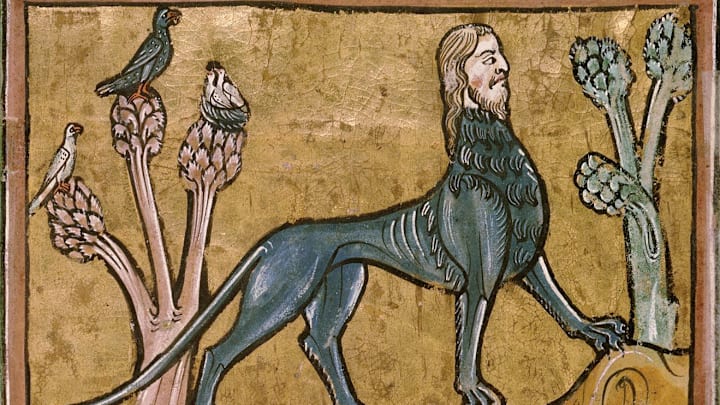Illustrations of animals feature frequently on the pages of medieval manuscripts, often in surprising ways—as is the case with the bewildering killer rabbits and goofy-looking lions that sometimes appear in the margins. Strange beasts popped up not only in texts devoted to other subjects, but also in bestiaries, tomes that were essentially compendiums of information about animals. The concept of a bestiary originated when writers like Pliny the Elder began creating works about natural history, then later became popular until the Middle Ages.
Bestiaries combined both real and imaginary animals. And contrary to what was once assumed, medieval people did not necessarily believe all the unusual creatures actually existed. They instead most likely viewed them as part of stories designed to illustrate things like religious allegories. Some fictional medieval animals, including dragons and unicorns, are the stuff of legend and are still famous today—but the menagerie of beasts depicted within these manuscripts also included much more obscure creatures.
Cetus

The cetus was a fearsome beast that brought terror to the seas and those who sailed them in Greek mythology. Illustrations in a manuscript by the French poet Phillippe de Thaon, dating back to at least 1376, show it having similar features to a whale; other sources describe it as being more like a shark. Cetus is also a constellation, as portrayed on the above map.
Cinnamologus

A cinnamologus, also known as a cinnamon bird, was a mythical beast that made its nests from cinnamon—which was then a scarce and highly sought after spice. The bird is usually shown perched high on a tree, sometimes with a human trying to knock it down and steal the cinnamon, as is the case in a 13th-century image from the Northumberland Bestiary.
Draconopede

Draconopedes featured elements of both dragons and serpents. In Christianity, serpents had negative associations due to the way the Bible portrayed one tempting Eve in the Garden of Eden; because bestiaries often included religious allegory, the appearance of draconopedes in the tomes was not uncommon. Some illustrations even show them as having a human face or head.
Griffin

A griffin was an odd mix of bird and mammal: Its head and wings were akin to an eagle’s, but its body was that of a lion. The strong creatures were often portrayed fighting against knights in battle. Griffins were sometimes described as living in distant locations—which modern commentators have observed may have been a way to explain why no one ever managed to see them in real life.
Leucrota

Like a number of legendary beasts, a leucrota (also called “crocotta”) was a mishmash of several animals. It had a lion’s chest, the legs and cloven hooves of a stag, and often a horse’s head. Its appearance was also distinguished by the wide grin on its face, as seen in the above image from the Bestiary of Anne Walshe, which dates from 1400–1425.
Manticore

The manticore had a lion’s body and, often, a human face; as one 13th-century scholar put it, “among all the beasts of the earth is none found more cruel, nor of more wonderly shape.” Its appearance varied depending on the source. Some show it with only the face of a person or with an entirely human head, while others portray the manticore as a goat-like animal without any noticeable human characteristics.
Monocheros

Unicorns were a popular feature of medieval bestiaries—but they weren’t the only fictional horned beings to appear. The monocheros (also commonly called “monocerus” or “monoceros”) had a stag’s head and what was said to be the body of a horse. They weren’t usually as sleek as a horse, though. Illustrations that accompanied a manuscript by Phillippe de Thaon make it appear a lot more goat-like, although others offer an alternative vision that’s a bit more elegant, yet still not entirely equine.
Tarasque

In French mythology, a tarasque was a half-animal, half-fish monster that shared some characteristics with a dragon. It could eat a human whole. According to legend, the tarasque wandered through the south of France, attacking people and sinking boats until it was defeated by Saint Martha. One of the most famous illustrations of the beast can be found in The Hours of Henry VIII.
Yale
This fantastical creature was described as being the size of a horse but having the jaws of a boar and the tail of an elephant. The Yale also had flexible horns it could move in any direction. It eventually became a part of English heraldry, featuring on decorations at the University of Cambridge before crossing the Atlantic and becoming a familiar symbol on the campus of Yale University.
Zitiron

Land animals weren’t the only strange hybrids lurking within medieval bestiaries. A zitiron (or zytiron) was a fusion of a human knight and a sea creature. They were also known as mer-knights or sea knights; some even compared them to sea turtles because of their armor-like shells.
Read More About Mythical Creatures:
